.
N - O - P - Q - R - S - T - U - V - W - X - Y - Z
Pantograph or Pointing machine?
Pointing machine a device to copy a 2 or three dimensional object. According to ArtLex it was used by the Greeks and Roman sculptors to produce copies of art. A Pantogragh is a 2 dimensional version and was reinvented in the Renaissance. See Pointing machine and Pantograph . I don't know if such a device was used earlier. There is a reference “Did the Greeks use a pointing machine?” Bulletin Archéologique 30 (2003) 55-64 but I have no access to this journal to provide more details.
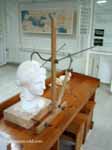
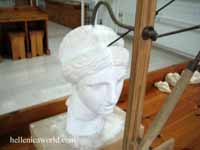
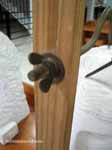

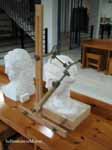
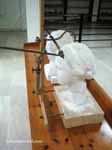
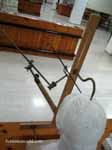
Pantograph, Archaeological Museum Dion
Parabolic Mirror or Parabolic Reflector
Some guess that in 214 BC Archimedes used many mirrors that approximated a parabolic mirror. Diocles the mathematician in his work On burning mirrors was the first to prove the focal property of a parabolic mirror. Applications of the parabolic reflector today: satellite dishes, optic and radio telescopes, parabolic microphones, lighting devices
Parchment
But it is worth reiterating that Western thought owes a great debt to the Egyptians, who invented books in the form of papyrus rolls. From the Pharaohs to the Ptolemies
About 170 BC
Parchment, superior to papyrus because it can be printed on both sides and folded, was invented in Pergamon. Pliny quotes Varro's statement that skins preparation for writing was invented in Pergamon at the beginning of the second century BC. Thus, at least as far as the Hellenistic world is concerned, the transition from papyrus to parchment may have been a matter of necessity, resulting from the Egyptian embargo on papyrus. Papyrus was invented in Egypt Unlike papyrus, an imported product outside Egypt, the parchment was durable and inaccessible to forgery. In Egypt, where the low humidity and the relatively cost-saving production of papyrus outweighed these advantages, papyrus remained the substance of choice. Tthe methods of skin preparation evolved in the course of time. The skin was taken from animals such as sheep, goats, or cows. In order to get a durable product that is easy to write upon, the unnecessary hair and the fat were removed and the skin was smoothed. The usual method involved soaking the hide in water, to which were added calcium or flour, to cause fermentation, and salt. An addition of tannin, made of oak-gall, produced an irreversible chemical reaction that strengthened the product. The raw skins were treated in different processes which led to a variety of the final product and to the different names, such as diphtera, gewil, etc. A material called parchment, first mentioned in 301 BC, is assumed to have been prepared by the people of Pergamon. The preparation was without tanning, so that the skin dried while being stretched. The final product was thin and very delicate. Writing on animal skins is known even before 2750 BC in Egypt.
David N. Carvalho : It is said that the skins of 300 sheep were used in every copy of the first printed Bible. Hence the old saying, "It takes a flock of sheep to write a book."
Information from: Meir Bar-Ilan
Patents
The Sybarites (from the Greek city of Sybaris in Southern Italy), having given loose to their luxury, made a law that. . .if any confectioner or cook invented any peculiar and excellent dish, no other artist was allowed to make this for a year; but he alone who invented it was entitled to all the profits to be derived from the manufacture of it for that time; in order that others might be induced to labour at excelling in such pursuits. Athenaeus (200 BC)
Devices (revolving prisms with painted scenery) used in the theater. It was probably used as early as Sophocles who is said to have used first paintings (scene decoration).
The parts of the scene are to be so distributed, that the middle door may be decorated as one of a royal palace; those on the right and left, as the doors of the guests. Near these are the spaces destined to receive the decorations; which places the Greeks call periaktoi , from the turning triangular machines. Each of these machines has three species of decoration, which, when the subject changes, or on the appearance of a god, are moved round with sudden claps of thunder, and alter the appearance of the decoration. Near these places the turnings run out, which give entrance to the scene from the forum and from the country. Vitruvius
Piston
By Ctesibius around 250 BC, see Pump.
Plato's Alarm Clock
Mechanism build by Plato using a water clock to produce a signal that tells the students that it is time to enter the Academy. Described by Aristocles a music theory expert of the 2nd centrury BC. Η. Diels, Antike Technik, Berlin 1914, page 199-200
Pozzolana (a Cement version)
230 BC. Properties of Pozzolana discovered. Cement in Ancient Greece Romans improve upon Greek technology and add broken brick and tile as well brick dust and volcanic ash (pozzoli) to produce lime mortar. Vitruvius indicates that Romans knew to burning argillaceous limestone would produce a hydraulic lime cement. (The Pantheon is an impressive example of the use of “cement” by Romans) Volcanic Ash in Ancient and Modern Construction
Pump of Ctesibius
By Ctesibius around 250 BC.
It is now necessary to explain the machine of Ctesibius, which raises water to a height. It is made of brass, and at the bottom are two buckets near each other, having pipes annexed in the shape of a fork, which meet at a basin in the middle. In the basin are valves nicely fitted to the apertures of the pipes, which, closing the holes, prevent the return of the liquid which has been forced into the basin by the pressure of the air. Above the basin is a cover like an inverted funnel, fitted and fastened to it with a rivet, that the force of the water may not blow it off. On this a pipe, called a trumpet, is fixed upright. Below the lower orifices of the pipes the buckets are furnished with valves over the holes in their bottoms. Pistons made round and smooth, and well oiled, are now fastened to the buckets, and worked from above with bars and levers, which, by their alternate action, frequently repeated, press the air in the pipes, and the water being prevented from returning by the closing of the valves, is forced and conducted into the basin through the mouths of the pipes; whence the force of the air, which presses it against the cover, drives it upwards through the pipe: thus water on a lower level may be raised to a reservoir, for the supply of fountains. Vitruvius
Pythagoras Cup of Justice
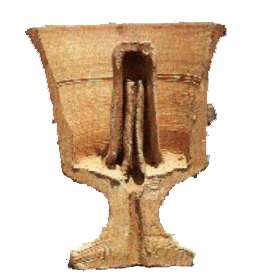
A Cup invented by Pythagoras. If the Cup was filled then an exterior tube in the center of the Cup was also filled through small holes in its bottom. When the level of the liquid in the Cup was above some mark then the liquid could flow through an inner tube allowing the liquid to escape the Cup. The result was that the Cup was emptied immediately by a “Suck Mechanism” as soon as the liquid level in the Cup exceeded the height of the inner tube. Pythagoras wanted to teach his students that they should be moderate. (Probably described also by Heron of Alexandria and known as Heron Cup or Tantalus Cup. Ref: Schlichting, H. J., Ucke, C., Der Trank aus dem Tantalusbecher, Physik in unserer Zeit 29 (1998) 174-176, in German. )
A - B - C - D - E - F - G - H - I- J - K - L - M -
N - O - P - Q - R - S - T - U - V - W - X - Y - Z
| Ancient Greece
Science, Technology , Medicine , Warfare, , Biographies , Life , Cities/Places/Maps , Arts , Literature , Philosophy ,Olympics, Mythology , History , Images Medieval Greece / Byzantine Empire Science, Technology, Arts, , Warfare , Literature, Biographies, Icons, History Modern Greece Cities, Islands, Regions, Fauna/Flora ,Biographies , History , Warfare, Science/Technology, Literature, Music , Arts , Film/Actors , Sport , Fashion --- |

